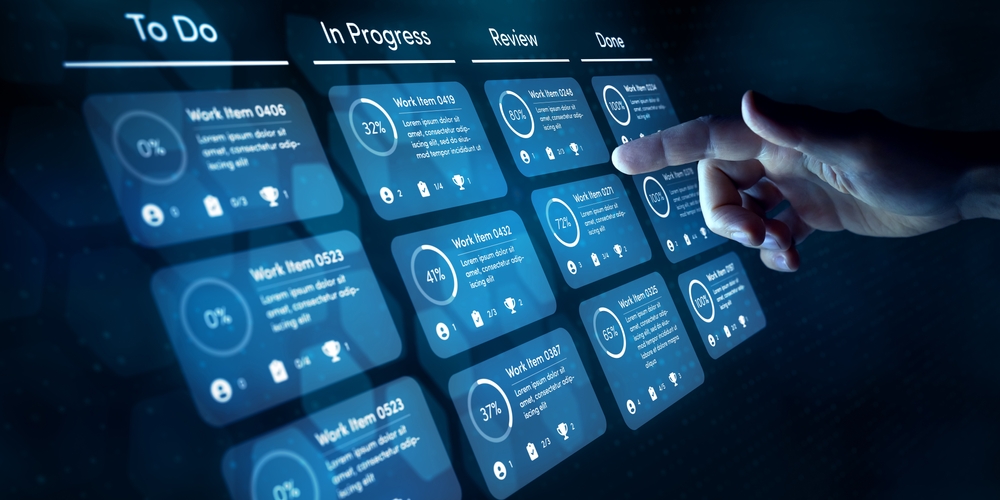Charting the Course: Key Trends Shaping Organizational Strategies in 2024
In the dynamic landscape of modern business, change management remains a steadfast pillar guiding organisations through tumultuous shifts and transformative endeavours. As we reflect on the strides made in the past year, marked by unprecedented global challenges and accelerated digital transformations, it becomes increasingly apparent that the winds of change continue to blow with unrelenting force.

Looking ahead to 2024, businesses are poised to embark on a journey that demands not just adaptation but proactive anticipation of evolving trends. From integrating advanced technologies to prioritising employee well-being amidst organisational flux, the realm of change management stands at the precipice of a new era, where agility, empathy, and innovation intertwine to sculpt the future of organisational resilience and success.
As we embark on this journey through the shifting tides of change management in 2024, it’s crucial to acknowledge the pivotal role of staying attuned to emerging trends. With businesses and organisations rapidly evolving in response to myriad influencing factors, the imperative to anticipate and adapt to change has never been more pressing. This year presents a unique opportunity to delve into the factors shaping the world of change management and explore the strategies, technologies, and approaches that will guide organisations through the turbulence of transformation. So, let’s delve into the top trends of 2024 and uncover the insights that will equip change management practitioners, business leaders, and enthusiasts with the tools they need to navigate the ever-evolving landscape effectively.
Organisational Agility and Redefining Work Structures:

The rise of remote and hybrid work models has fundamentally transformed how organisations operate, prompting a reevaluation of traditional work structures and methodologies. In response to this shift, organisations are increasingly embracing organisational agility and redefining their work structures to adapt to the changing landscape.
One key aspect of this trend is the move towards collaborative networks of self-managing teams. Rather than relying on rigid hierarchical structures, organisations are flattening their hierarchies and empowering teams to make decisions autonomously. This agile approach enables teams to respond quickly to changing circumstances, allowing for rapid cycles of work and iteration.
By embracing self-managing teams, organisations can foster a culture of innovation and creativity, as team members are encouraged to take ownership of their work and experiment with new ideas. This approach also promotes collaboration and cross-functional communication, as teams work together towards common goals.
However, while the agile approach offers many benefits, it also presents challenges. Traditional methodologies like Agile, which were designed for co-located teams, may struggle to adapt to the complexities of remote and hybrid work environments. As a result, organisations may need to seek a balance between methodologies like Waterfall and Agile to ensure optimal project delivery.
Waterfall, with its sequential approach to project management, may offer more stability and predictability in certain situations. However, it lacks the flexibility and adaptability of Agile, making it less suitable for fast-paced environments where change is constant.
Ultimately, organisations must carefully consider their unique circumstances and goals when redefining their work structures. By embracing organisational agility and fostering collaborative networks of self-managing teams, organisations can adapt to the challenges of remote and hybrid work models while remaining innovative and competitive in today’s rapidly evolving business landscape.
Employee Well-being and Empathy-driven Leadership:

The evolving landscape of the modern workplace has brought a heightened focus on employee well-being and mental health, recognising them not merely as personal concerns but as crucial determinants of productivity, engagement, and organisational success. This paradigm shift underscores the growing awareness among employers that the mental and emotional health of their workforce directly impacts overall performance and effectiveness.
At the forefront of navigating this shift are mid-level managers who play a pivotal role in balancing empathetic leadership with meeting increased business objectives. These managers are tasked with fostering a supportive and inclusive work environment while simultaneously driving performance and achieving organisational goals. This requires a delicate balancing act that highlights the importance of emotional intelligence and empathetic digital management.
Empathetic leadership involves understanding and addressing the needs, concerns, and emotions of employees, demonstrating genuine care and concern for their well-being. Mid-level managers must cultivate empathy in their interactions with team members, actively listening to their concerns, providing support and encouragement, and fostering a sense of belonging and psychological safety within the team.
Moreover, as business objectives become increasingly demanding, mid-level managers must navigate the delicate balance between empathetic leadership and meeting performance targets. This requires the ability to effectively prioritise tasks, delegate responsibilities, and provide constructive feedback, all while maintaining a supportive and empathetic demeanour.
In the digital age, where remote work and digital communication are prevalent, empathetic digital management becomes especially crucial. Mid-level managers must leverage technology to facilitate meaningful connections and foster a sense of community among team members, despite physical distance. This may involve utilising video conferencing platforms for face-to-face interactions, implementing virtual team-building activities, and providing additional support and resources for employees struggling with remote work challenges.
Ultimately, by prioritising employee well-being and embracing empathetic leadership, mid-level managers can create a positive and supportive work environment that fosters engagement, resilience, and organisational success. Through their efforts, organisations can nurture a culture of empathy, compassion, and collaboration, driving performance and innovation in today’s dynamic and ever-changing workplace landscape.
Demographic Shifts in the Workforce:

The demographic landscape of the workforce is undergoing significant transformation, marked by the rise of Generation Z entering the workforce in larger numbers and a growing population of older workers choosing to extend their careers. These demographic shifts present challenges and opportunities for organisations as they strive to create inclusive and supportive environments that cater to employees’ diverse needs and expectations across different generations.
With Generation Z outnumbering baby boomers for the first time in the workplace, organisations must adapt their policies, practices, and organisational culture to resonate with this younger cohort’s values, preferences, and work styles. Generation Z is characterised by its digital nativism, entrepreneurial spirit, and desire for meaningful work experiences. Organisations need to embrace technology, foster innovation, and provide opportunities for learning and growth to attract and retain Gen Z talent.
Simultaneously, the growing presence of older workers in the workforce presents unique challenges and opportunities. Many older workers are choosing to extend their careers due to economic factors, improved health, and a desire for continued engagement. Organisations must recognise the value of older workers’ experience, expertise, and institutional knowledge while also addressing their specific needs and preferences. This may include offering flexible work arrangements, providing opportunities for skills development and retraining, and creating age-inclusive policies and practices.
Furthermore, organisations must adopt a multi-generational approach to talent management, recognising that each generation brings unique perspectives, skills, and contributions to the workplace. By fostering a culture of diversity, equity, and inclusion, organisations can leverage the strengths of employees across different age groups and create a more dynamic and innovative workforce.
Effective communication and collaboration across generations are also essential for fostering understanding, respect, and cohesion within the workforce. Organisations should encourage intergenerational mentoring and reverse mentoring programs to facilitate knowledge sharing and skill transfer between employees of different age groups.
In summary, the changing demographic composition of the workforce presents both challenges and opportunities for organisations. By adapting their policies, practices, and organisational culture to accommodate the diverse needs and expectations of employees across different generations, organisations can create inclusive, supportive, and thriving workplaces that harness the full potential of their multi-generational workforce.
Adoption of Emerging Technologies and AI:

The adoption of emerging technologies, particularly artificial intelligence (AI), presents both challenges and opportunities for managers and organisations across various industries. As AI continues to evolve and become more sophisticated, managers are grappling with how to harness its potential effectively while mitigating potential risks and challenges.
One of the key challenges faced by managers is understanding the various applications of AI and how they can be leveraged to drive innovation and improve business outcomes. From machine learning algorithms to natural language processing and computer vision, AI technologies offer a wide range of capabilities that can transform business operations, enhance decision-making processes, and create new opportunities for growth.
However, the adoption of AI also raises concerns about ethics, privacy, and the impact on the workforce. Managers need to carefully consider the ethical implications of AI-powered systems, such as bias in algorithms, data privacy issues, and the potential displacement of jobs due to automation. They must ensure that AI technologies are deployed responsibly and ethically, taking into account the interests of all stakeholders, including employees, customers, and society at large.
In addition to ethical considerations, managers must also grapple with the practical challenges of implementing AI within their organisations. This may include acquiring the necessary technical expertise, integrating AI systems with existing infrastructure and processes, and ensuring data security and compliance with regulatory requirements.
Furthermore, managers need to make informed decisions about which AI technologies to adopt and how to prioritise investment in emerging technologies. This requires a strategic approach to technology adoption, with careful consideration of the potential risks and rewards associated with each technology.
One area of emerging technology that managers are increasingly exploring is generative AI, which has the potential to revolutionise various industries, including creative fields such as art, music, and literature. Generative AI systems can produce original content, simulate human-like behaviour, and even generate new ideas and solutions to complex problems.
However, managers must also be mindful of the limitations and challenges associated with AI adoption, such as the need for robust data governance practices, ongoing training and development for employees, and the potential for unintended consequences or ethical dilemmas.
Overall, the adoption of emerging technologies like AI presents managers with both challenges and opportunities. By navigating the digital landscape strategically, staying informed about the latest developments in AI technology, and fostering a culture of innovation and experimentation, organisations can position themselves for success in an increasingly AI-driven world.
Performance Management and Productivity:

In response to the pervasive issue of work-induced stress and fatigue among managers, as highlighted in Gartner’s 2023 research, organisations are undergoing a significant shift in how they measure and incentivise success. With a staggering 54% of managers experiencing this stress, it’s become evident that superficial solutions are no longer sufficient.
Organisations are now redefining their approach to performance management, placing a heightened emphasis on productivity and transparent expectations. This necessitates a fundamental redesign of work processes, culture reinforcement, and the realignment of individual motivations within the workforce.
Transparent performance expectations and incentives play a pivotal role in driving success within organisations. Employees need clear guidance on what is expected of them and how their performance will be evaluated. By establishing transparent metrics and goals, organisations can provide employees with a clear roadmap for success, fostering a sense of accountability and empowerment.
Furthermore, organisations are recognising the importance of fostering a supportive and inclusive work culture that reinforces productivity and performance. This involves creating an environment where employees feel valued, supported, and motivated to excel. Managers play a critical role in this process by providing ongoing feedback, recognition, and support to their teams.
Additionally, organisations are exploring new ways to realign individual motivations with organisational goals. This may involve revisiting incentive structures, providing opportunities for skill development and career advancement, and fostering a sense of purpose and meaning in the work employees do.
Overall, the shift towards performance management and productivity reflects a broader recognition of the need to address workplace stress and fatigue. By prioritising transparent expectations, fostering a supportive work culture, and realigning individual motivations, organisations can create a healthier and more productive work environment for their employees.
Sustainability and Compliance:

The recent survey by Prosci found that environmental sustainability and climate change are among the top five biggest changes on the horizon for 2024. The evolving conversation around sustainability underscores a significant shift in organisational priorities, driven by both external pressures and internal recognition of the importance of environmental stewardship. Organisations are facing increased scrutiny from stakeholders, including consumers, investors, and regulators, to address environmental issues and adopt sustainable practices.
One key aspect of this trend is the growing emphasis on compliance with regulations related to sustainability. Governments and regulatory bodies around the world are implementing stricter environmental standards and reporting requirements, compelling organisations to adhere to these guidelines or face potential legal and reputational consequences. For example, initiatives like the EU’s Corporate Sustainability Reporting Directive (CSRD) impose stringent non-financial reporting regulations on larger organisations, requiring them to disclose their environmental impact and sustainability efforts.
In response to these regulatory pressures, organisations are integrating sustainability into their business operations and decision-making processes. This involves adopting sustainable practices across various aspects of their operations, such as reducing carbon emissions, minimising waste, conserving resources, and sourcing ethically and responsibly. Additionally, organisations are investing in technologies and initiatives that enable them to track, measure, and report on their sustainability performance accurately.
Moreover, sustainability is increasingly being viewed not just as a compliance issue but also as a strategic imperative and a source of competitive advantage. Organisations that embrace sustainability can differentiate themselves in the marketplace, attract environmentally conscious consumers, and enhance their brand reputation. By aligning sustainability goals with broader business objectives, organisations can drive innovation, reduce costs, and create long-term value for shareholders.
Overall, the trend towards sustainability and compliance reflects a broader recognition of the interconnectedness between business success and environmental responsibility. As organisations navigate this evolving landscape, integrating sustainability into their core business practices will be essential for achieving long-term viability and resilience in an increasingly environmentally conscious world.
In Summary:

The landscape of organisational dynamics in 2024 is marked by a convergence of diverse trends reshaping the way businesses operate and thrive. From embracing organisational agility and redefining work structures to prioritising employee well-being and empathy-driven leadership, organisations are navigating a complex terrain where human-centric approaches intersect with technological advancements. Demographic shifts in the workforce, with Gen Z emerging as a dominant force alongside an increasing number of older workers, underscore the importance of accommodating diverse needs and expectations. Meanwhile, the adoption of emerging technologies like AI presents both challenges and opportunities, requiring strategic navigation to stay competitive. Amidst these transformations, sustainability and compliance have risen to the forefront, emphasising the integration of environmental responsibility into business practices. As organisations navigate these trends, they are redefining success through a lens of productivity management, transparency, and sustainability, positioning themselves to thrive in an ever-evolving business landscape characterised by change, innovation, and resilience.